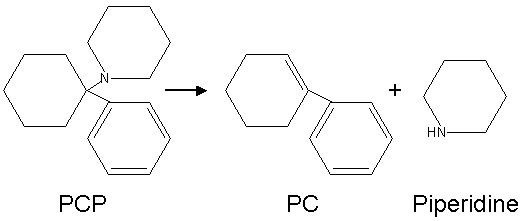Phencyclidine
|
|
PCP.jpg
Illicit PCP seized by the DEA.
Phencyclidine (also called PCP or Angel dust) is a psychedelic drug. (Specifically, it is a dissociative drug. The dissociatives are a major subclass of the psychedelic drugs.) PCP was commercially developed in the 1950s by the Parke-Davis pharmaceutical company. Internationally, PCP is a Schedule II drug under the Convention on Psychotropic Substances[1] (http://www.incb.org/pdf/e/list/green.pdf).
| Contents |
Chemistry and pharmacology
Chemically and pharmacologically it is very similar to ketamine, and in effects very similar to DXM. However, one important difference is the excretion of the molecules, going on rather rapidly in the case of ketamine, but extending over weeks in the case of PCP.
Medical uses
PCP was first tested after World War I as a surgical anaesthetic; however, because of its bad side-effects it was shelved until the 1950s. It was then patented by Parke-Davis and named Sernyl (supposedly referring to serenity), but was again withdrawn from the market because of its side effects. It was soon renamed Sernylan, and marketed as a veterinary anaesthetic, but once again its use was discontinued. Its side effects, and its long half-life in the human body, made it unsuitable for medical applications. It is retained in fatty tissue and is broken down by the human metabolism into PCHP, PPC and PCAA. When smoked, some of it is broken down by heat into 1-phenyl-1-cyclohexene (PC) and piperidine.
Recreational use
PCP is sometimes consumed recreationally, mainly in the United States. The limited demand is met by illegal production. The drug is sold in an extremely limited number of cities. It is available as a liquid (PCP base dissolved most often in ether), but typically it is sprayed onto leafy material such as marijuana, mint, oregano, or parsley, and smoked.
In its pure form, PCP is a white crystalline powder that readily dissolves in water. However, most PCP on the illicit market contains a number of contaminants as a result of makeshift manufacturing, causing the color to range from tan to brown, and the consistency to range from powder to a gummy mass.
Effects
Whether PCP has any strong and consistent effects which are markedly different from other similar compounds is controversial. Some think that the drug's effects are as varied as its appearance. It may be that a moderate amount of PCP will cause users to feel detached, distant, and estranged from their surroundings. Numbness, slurred speech, and loss of coordination may be accompanied by a sense of strength and invulnerability. A blank stare, rapid and involuntary eye movements, and an exaggerated gait are alleged to be among the more observable effects.
Auditory hallucinations, image distortion, severe mood disorders, and amnesia may also occur. In some users, PCP may cause acute anxiety and a feeling of impending doom; in others, paranoia and violent hostility; and in some, it may produce a psychosis indistinguishable from schizophrenia. Modification of the manufacturing process may yield chemically related analogues capable of producing psychotic effects similar to PCP.
Trends
PCP production is centered in the greater Los Angeles metropolitan area. Los Angeles-based street gangs, primarily the Crips, continue to distribute PCP to many cities in the United States using their cocaine trafficking operations. These gangs pose a particular problem due to their propensity for violence. During the late 1980s and early 1990s, the widespread availability and use of crack cocaine displaced demand for PCP. More recently, however, reporting suggests that PCP abuse is increasing slightly in many cities, as some crack addicts return to the use of this drug. For instance, the DEA Portland District Office reports a resurgence in the popularity of liquid PCP, also known as "sherm", among Portland area gangs. California street gangs reportedly are responsible for the reemergence of PCP in the Pacific Northwest. Treated cigarettes, which have a yellow tint caused by the liquid PCP, were first observed on the street in 1996, costing between $15 and $20 each. The DEA Philadelphia Field Division also reports that PCP was available readily in the region in 1998. The DEA seized three clandestine PCP laboratories in 2004.
Mythology
More so than any other illegal substance, PCP has developed an elaborate mythological history surrounding itself, spread by sources such as D.A.R.E. PCP is said in this urban legend to cause such entirely realistic hallucinations, such as that of spiders on the users' faces, which in turn causes them to create deep lacerations in the attempt at removing them.
Another famous mention is in the movie Terminator, where the violent attacks by the character played by Arnold Schwarzenegger, including punching through a glass window without feeling it, are attributed to PCP by the police. However, dissociative anesthetics (including PCP) most typically induce closed eye hallucinations, though fully-formed open eye effects are occasionally reported. Studies of PCP users fail to substantiate a significant correlation between use of the drug and subsequent violent behavior in previously non-violent individuals.
External link
- Information on the related drug DXM (dextromethorphan) (http://www.dextromethorphan.ws/)
- DEA brief (http://www.usdoj.gov/dea/pubs/intel/99024/99024.html)
- The Vaults of Erowid (http://www.erowid.org/chemicals/pcp/pcp.shtml)
Template:Dissociative hallucinogensda:Fencyklidin
de:Phencyclidin
nl:Fencyclidine
pl:Fencyklidyna


